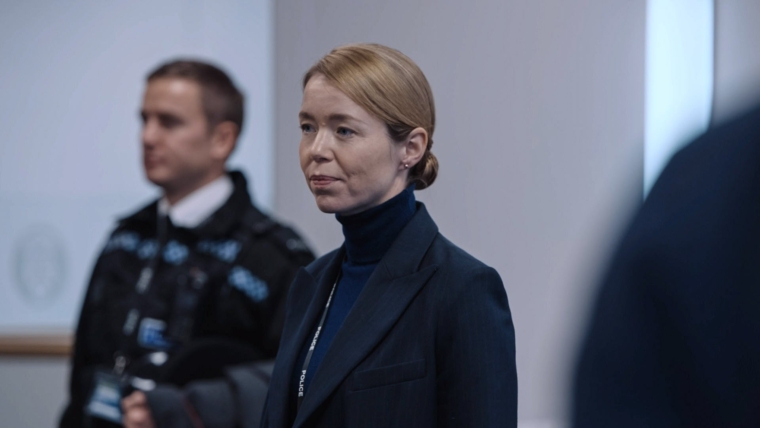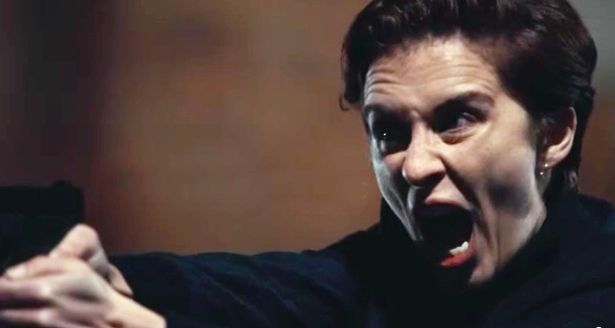Summary
With only two episodes to go, there’s plenty still left to unfold, including finding out which connections to previous seasons are red herrings and which are the real thing.
This recap of Line of Duty season 6, episode 5 contains spoilers.
Just two more episodes to go. Line of Duty season 6, episode 5 opens with the death of Jimmy Lakewell, from near the end of the previous episode, being investigated by AC-12. Of course: no CCTV. And double-plus of course: it’s been made to look like a suicide. All is not lost from this witness though. As suspected, Lakewell had given DI Steve Arnott a lead just before the ambush last week: Gail Vella had been looking into the death of a young black man, Lawrence Christopher, who had died in police custody in 2003.
Meanwhile, the Murder Investigation Team is considering links between Vella’s death and the armed robbery which caused a delay in reaching a key suspect (back in episode 1), you know, just in case it was executed at that moment deliberately. DS Chris Lomax (I keep wondering if he’s too good to be true) posits that a route to a link would be finding the gun workshop, and has come up with a few industrial estates to check out nearby. The “new Caddie”, PC Ryan Pilkington is not happy about this. DI Kate Fleming tries for a chat with DCI Joanne Davidson but gets firmly brushed off.
Fleming has been invited to catch up with AC-12, and the meeting is all about Davidson. Excellent: let’s find out about that “blood relative”. They lead into that by revealing to Fleming that Davidson is under surveillance: her DNA found at PS Farida Jatri’s home turned out to be a partial match to Tommy Hunter, the (now deceased) criminal puppet master from seasons 1 and 2; and the type of match (homozygosity) suggested that identical genes came from both parents. So Hunter, a known pedophile, also engaged in incest; and it looks like troubled Davidson was the result. To Superintendent Ted Hastings, this can only be confirmation that Davidson is connected to the Organised Crime Group and sympathizes over Fleming’s loyalty to her.
Davidson, meanwhile, checks her messages. She had told “Unknown User” that she was finished (presumably being controlled by the OCG), but they reply with “AC-12 aren’t. So neither are you.” Drat.
Chief Constable Philip Osborne (Arnott’s original boss in the opening season, and major cover-up artist) is on TV in Line of Duty season 6, episode 5, declaring that there’s too much politics involved with the police force. Hastings storms out at this and goes to see Police and Crime Commissioner Rohan Sindwhani to find out what’s behind the press conference: turns out Osborne is the one behind the department’s restructuring and PCC Sindwhani has been trying to fight it. Now he finds himself obliged to resign and encourages Hastings to prove the extent of corruption while he still can.
Less than ten minutes into the show. Really. This is a dense one and honestly, you can’t afford to miss a detail: social media is the new water cooler for work chats.
Next, a brief scene about the money that Arnott found in Steph Corbett’s loft: forensics have come back and there is a perfect shot of his reflection – in both senses – when he realizes the implication. Not knowing who else to confide in, he meets with Fleming (this time in a car park, not subway). The banknotes come from the same batch the OCG tried to bribe Hastings with in the last season. They’re puzzled about why Hastings would have given some to Steph, but work it out a bit later. Steph and Arnott talk on the phone and both seem awkward about whether to continue their relationship. Not surprised!
Fleming briefs the MIT about a likely site for the OCG workshop, and only Davidson has prior notice. With extreme reluctance (most vocally, DS Chris Lomax), everyone in the team gives up their phones to prevent leaks, until they’ve had a chance to check the site. Davidson leads by example, and Pilkington is clearly concerned about the whole thing, especially when he sees Davidson and Fleming conferring some more behind a closed door. Pilkington is watching Fleming’s every move now, but she’s keeping a close eye on him too, telling him which car to ride with both too and from that raid.
The raid on the workshop site, at Lockside Yard, reveals nothing. Pilkington sneaks out and makes a call with another phone he had hidden in a sock… DC Chloe Bishop is watching and taking pictures, though, which the complacent little thug doesn’t notice. Lockside is just one possible location out of three, though: the team split with half going next to Whiterock Park and the other half to Knights Courtyard. AC-12 also has surveillance on both sites and Arnott, at Whiterock Park, sees “possible OCG activity” (tipped off by Pilkington?) and his team moves in before MIT has the chance to get there. Result: two OCG shot, and a clash of agendas. Arnott is not precious about declaring to Davidson that AC-12 was there due to surveillance on the same OCG as her team has an interest in, due to connections with the ambush in last week’s episode. Davidson insists on taking charge of the scene, having clocked that one of the men shot is the one who passed her a phone back in episode two.
Fleming and Arnott still have opposing theories about Davidson’s loyalties, but they put their difference aside and discuss the suspects found (and shot dead) at Whiterock: Lewis Polkard and Darren Morgan. Bishop announces officers are ready to bring Pilkington in, but Hastings decides to hold back: if they wait, he’ll lead them to “the big fish”. Hastings has clearly taken to heart Sindwhani’s advice about a legacy.
Plenty of evidence found at Whiterock, so the MIT are excited to get stuck in; except, of course, for Pilkington. Davidson can’t stare him down for long.
In the meantime, Bishop has been looking into the issues surrounding Lawrence Christopher’s death. He was racially mocked by officers, died from a concealed skull fracture; witnesses were not questioned properly, and neither officers nor suspects held to account. Hastings declares this to be a “shameful episode” but doesn’t see how it could lead to Vella’s murder. Bishop is wrung out by her research, and Arnott alone offers a little sympathy.
This scene, right in the middle of the episode, is interesting for a couple of reasons. Firstly this case study is an amalgam of two genuine cases of black men who were killed in Britain, and which were considered to demonstrate institutional racism in the police force: Stephen Lawrence and Christopher Alder. Secondly, the way the case of the fictitious Lawrence Christopher was recounted by Chloe Bishop, a black person herself, is controversial: she has had no character development or depth until now but is given center stage in this scene; fairly typical that a black character is used in this way, especially as her report is virtually dismissed by her white boss. It is difficult to say whether writer Jed Mercurio is demonstrating a real-life race-related dynamic within the police or inadvertently falling foul of a stereotype by using Bishop’s character in this way. Considering the patience awarded to the scene, I would like to think it is the former. Let’s see if she has the chance to develop in the next week or two.
The Senior Investigating Officer in the Christopher case was Detective Chief Inspector Marcus Thurwell (James Nesbitt), a name connected to the child sex exploitation case at Sands View Boys Home in season three, now in Spain. More digging reveals that both Ian Buckells and Philip Osborne served in Thurwell’s team at that time. Presumably, via Thurwell’s name, Vella took an interest in the person finally convicted in the Sands View case, Patrick Fairbank (George Costigan): she had requested an interview with him in prison, but she was murdered before it could take place. Arnott and Bishop visit Fairbank, but his dementia has progressed and the meeting just leads to frustration.
Back at MIT (or rather, outside the offices), Davidson confronts Fleming about the AC-12 knowledge of the workshop sites, and Fleming has no qualms about admitting she told both teams about her findings. Clearly piqued about this dual loyalty, Davidson suggests Fleming requests a transfer back to AC-12, but Fleming – concerned about changes in their friendship – is not leaving. At home, Davidson gets back in touch with her OCG contact and asks for time to deal with AC-12. No such luck. She is told to “get rid of her”, and that it is “definately” her last job.
Blackthorn Prison houses many characters from previous seasons of Line of Duty by now, and it turns out Gail Vella had requested interviews with pretty much all of them. Interestingly, all the “bent coppers” had declined, but OCG member Lee Banks went for it: yes, brother of Carl, who is suspected to have murdered Vella just two weeks later. Did he figure out what she knew, pass it on via Carl, who was then told to kill her? Arnott puts Lee Banks on the spot about this, but – still bitter about Arnott having caught him – Banks tells him his brother was never “a rat”, but he had found out from Hastings that there was a rat in his crew that turned out to be an undercover police officer, John Corbett. Arnott joins the dots then from Hastings’ guilt to Steph’s envelope of money.

Like last week’s episode, the final fifteen minutes was made up of two major plot strands that steadily come together. Firstly, Davidson invites Fleming to talk and then crumples into tears as soon as privacy allows: clearly doesn’t want to get rid of Fleming, and feeling just as anxious as Line of Duty fans. Next, having kept digging, we see Bishop present new findings: one of the gang that caused Lawrence Christopher’s death was Tommy Hunter’s son Darren. If Hunter is long dead, was it instead one of the officers involved at that time who ordered Vella’s murder? Bishop raises again the names of Buckells and Osborne, taken more seriously this time… but attention turns to Detective Chief Superintendent Patricia Carmichael (Anna Maxwell Martin) arriving at AC-12 with an entourage. (To many fans who watched season five, this is a character they love to hate; as for me, I think I’d love to be her: she is Cruella de Vil in a sharp trouser suit.)
Carmichael meets Hastings in his office for a dramatic tearing down of his team’s work so far, and it’s worth rewatching the episode for this exchange alone. She declares he is wasting money on too much surveillance, and – starting her new role to replace Hastings early – she halts all of it, immediately, to Hastings’ strident protest.
The tension builds up in the other plot strand: Davidson changes plans to meet Fleming, under Pilkington’s supervision, luring her to a dark and empty lorry park. Fleming is naturally wary and calls Arnott to ask if surveillance has noticed anything suspicious: he’s just telling her about Carmichael’s suspension of surveillance when Carmichael herself enters and takes the phone, announcing herself to Fleming as the new Senior Investigating Officer. Fleming hangs up the phone!
Davidson arrives at the secluded meeting, and Fleming remembers just then to forward the address to Arnott. Carmichael tries to stop AC-12 from going to support Fleming, but Hastings still has his leader voice: “That’s my officer out there. I’ll breathe when she’s safe.”
Guess what: she’s not safe. Pilkington has arrived with Davidson, points a gun at Fleming, and declares she should have taken the transfer. They play “who’s toughest”, with Fleming calling Pilkington a “little boy”, and him pretty much confessing to killing both John Corbett and Maneet Bindra (in season five) to prove her wrong. The scene escalates with both holding guns on each other and Davidson trying to duck out of the situation: “Drop the gun!” “Drop yours!”
Two shots are fired as the screen goes black…
It wouldn’t surprise me if the next episode opens with us finding out that Fleming is dead: it would be a natural tragic end to the arc of her building bridges with AC-12 and making up with Hastings again. It could be poor writing though unless done carefully, as she is known to be a good shot. Maybe AC-12 will turn up in time to see what Mercurio doesn’t want us to see yet. Maybe Arnott will punch Carmichael for suspending the surveillance: it will be an effective way of avoiding the Occupational Health calls after all.
There’s still so much to unfold in the next two episodes. They’ve filled season six with myriad (too many?) connections to other seasons, surely some will be red herrings. And surely we’ll find out if Hastings is right about a “fourth man” still being out there. Watch this space, or watch BBC One.



